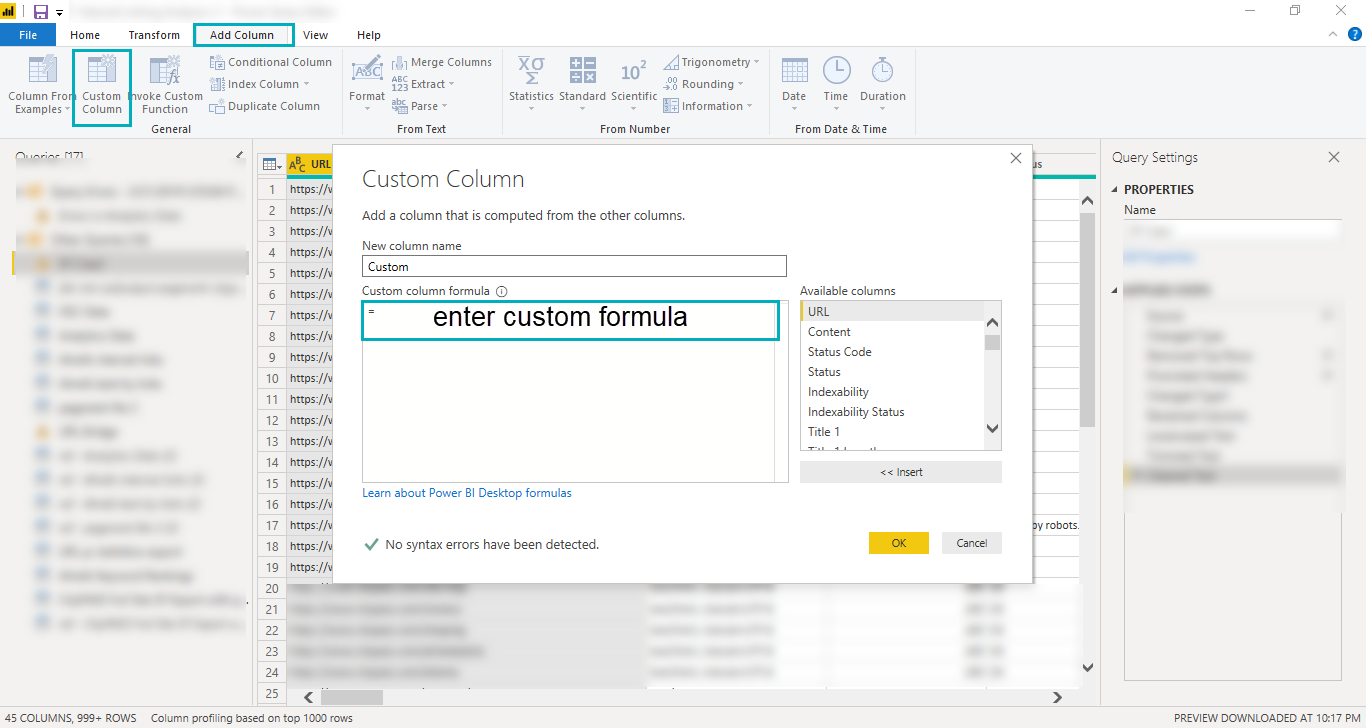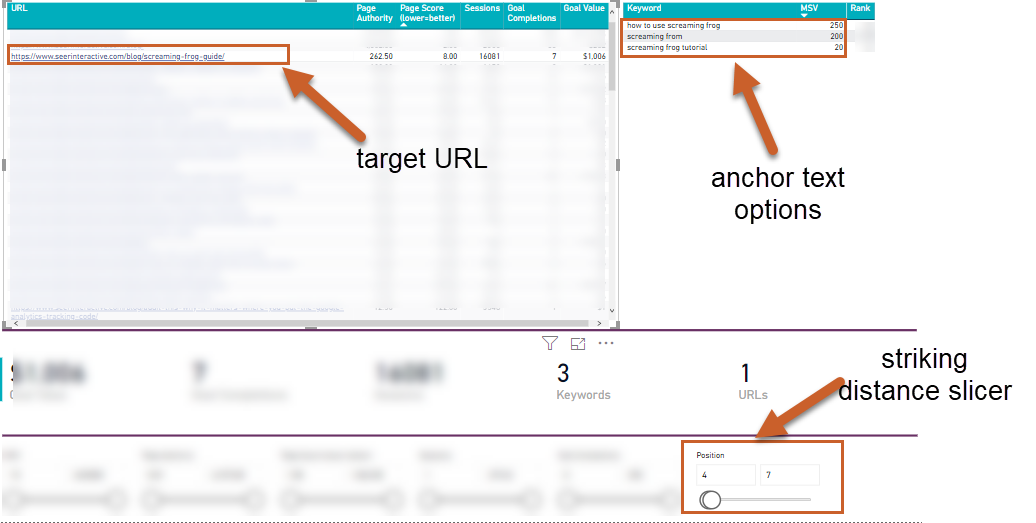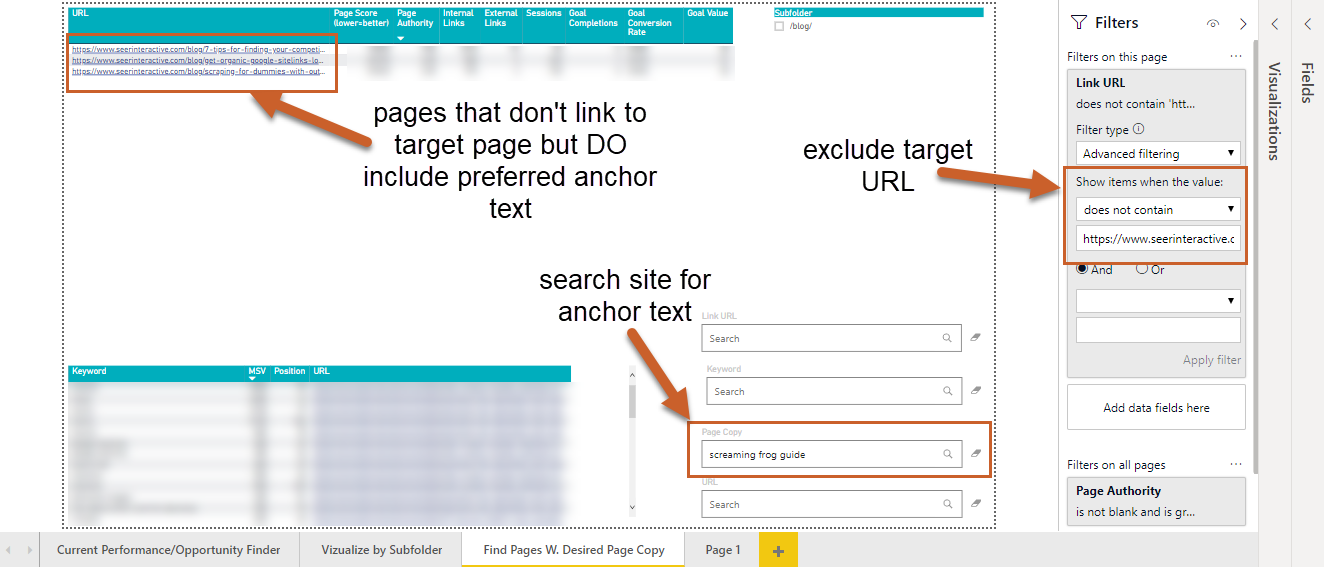I recently found myself in a situation that required me to find internal linking opportunities for two separate clients. For me, finding internal links typically takes a lot of time and is a very tedious (and boring) task. For that reason, I think internal linking opportunities are often missed. Now that I needed to find internal links, I wanted to find a way to identify opportunities in a faster, more efficient manner. So my colleague on the Technical SEO team, Allison Hanh, and I got together and created a tool in Power BI to help us do just that.
How We Built An Internal Linking Tool
Step 1: Gather Your Data
- Keyword Rankings (from your tool of choice)
- Ahrefs Best by Links
- Ahrefs Internal backlinks
- Screaming Frog All Outlinks Bulk Export
- Screaming Frog Crawl of your entire site with page copy
- Google Analytics Organic Landings Pages Export (optional)
Step 2: Join Data in Power BI
If you don’t know how to do this, check out the Seer YouTube Channel or some of our blog posts about Power BI.
Step 3: Create a Custom Metric to Score Your Existing Content (URLs)
- Allison and I used a script for RStudio based on internal and external backlinks to score each URL of the sites we were working with
- Not familiar with RStudio? Check out this gnarly piece of content from Search Engine Land to help you get started
- You can also create your own custom metric by creating a custom column in the Power BI query editor and creating your own formula that weighs different metrics

Step 4: Find Opportunities & Get Them Implemented!
It probably sounds too easy!
How To Find Internal Linking Opportunities Across An Entire Domain
This process is much easier and less time-consuming if you take the time to follow the steps above and get everything into Power BI. However, if you don’t use Power BI, you can still find strong internal linking opportunities by tweaking what I’m about to outline below.
Find Strong Anchor Text
Anchor text is an important part of linking. You need to make sure that the text you use to link to your target page is relevant. This is where the keyword rankings come into play.
How to Complete This With Power BI
- Use a slicer to choose the URL you’d like to link to
- Use a slicer to narrow your keywords down to only keywords that fall within striking distance
- Choose the best set of words that fit the category of your page
- BOOM - there is your anchor text

How to Complete This Without Power BI
- In either a Google Sheet or Excel file, add filters to your columns
- Use the filtering option to choose the URL you’d like to link to
- Use the filtering option to choose keywords in striking distance

Now that you’ve found your anchor text, what’s next?
Finding Pages to Internally Link From
This is where Power BI really comes in handy. Now that you’ve identified the anchor text you’d like to use, you need to find where that text lives on the site so that you can use the anchor text to add a link to your target page. When you were reviewing the data sources used for this, you probably noticed “Screaming Frog Crawl of your entire site with page copy.”
We used a custom extraction in Screaming Frog with XPATH to capture all of the copy that lives on each URL on the site. When we loaded this into Power BI we quickly merged all of the page copy columns together, cleaned the data, and got to work. This is still doable in Google Sheets or Excel, but not as easy and/or quick. The alternative is to not use the Screaming Frog crawl, and just perform a “site:” search in Google or your preferred search engine.
At this point, you can also use your custom metric that you used to score pages to see which pages need some links and which pages have a little love to give.
Now it’s time to find where your anchor text lives on your site.
How to Complete This With Power BI
- Use a search filter for your page copy and search for your anchor text
- In the ‘Filters” pane to the right, add a filter to exclude pages that are already linking to your target page (we did this by using the Ahrefs Internal backlinks data)
- Now you should have every single URL that contains your anchor text without an internal link to your target page!

How to Complete This Without Power BI
Option 1: Google Sheets or Excel
- Merge all columns containing page copy into one column
- Add the column filtering option to the columns
- Use the filters to search for “text containing” and include your anchor text
- Open the URLs and do a control search (“Ctrl + F”)
- Make sure there isn’t already an internal link to your target page
- Add recommendation
Option 2: “site:” Search in Google (or another Search Engine)
- Perform your search for your domain
- (example search query - site:seerinteractive.com )
- Add your anchor text in parentheses
- Open the results (preferably in another tab) and do a control search (“Ctrl + F”)
- Make sure there isn’t already an internal link to your target page
- Add recommendation
As you can see, these methods can be time-consuming because the search results are still going to show pages that are already linking to my target URL. So this method takes more time and is very tedious (and super boring).
![]() Final Thoughts
Final Thoughts
By utilizing Power BI, we can identify opportunities for internal links much quicker than traditional methods, giving us more time to spend on strategy and solving other problems. Whether you are adding internal links from a purely tactical standpoint or adding internal links as a larger strategy, saving time and being more efficient should entice you to get rocking with Power BI and make the most of your time and your client’s money.
If you found this helpful, check out what else we have to say. Already knocking things like this out of the park and looking for a new challenge? Well, we’d love to meet ya, so check out our open positions!
Subscribe to the Seer blog for more Power BI tutorials, tips and tricks, and industry updates!


